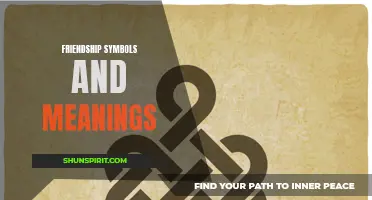
The scarab beetle has been a fascinating symbol throughout history, revered by ancient Egyptians as a representation of life, rebirth, and protection against evil. This small creature holds great significance in various cultures and has become a timeless emblem of transformation and spiritual enlightenment. Join me as we delve into the intriguing scarab symbol meaning and explore the profound messages it holds for humanity.
What You'll Learn
- What is the scarab symbol, and what does it represent in ancient Egyptian mythology?
- How did the ancient Egyptians incorporate the scarab symbol into their artwork and jewelry?
- Are there any specific qualities or characteristics associated with the scarab symbol in Egyptian culture?
- Does the scarab symbol have any significance or meaning in other cultures or belief systems?
- How has the scarab symbol been interpreted or used in modern times?

What is the scarab symbol, and what does it represent in ancient Egyptian mythology?
The scarab is one of the most iconic symbols in ancient Egyptian mythology and culture. In Egyptian mythology, the scarab beetle was associated with the sun, rebirth, and the cycle of life. The ancient Egyptians believed that the scarab beetle had the ability to regenerate itself and therefore saw it as a symbol of resurrection and eternal life.
The scarab beetle itself played a significant role in ancient Egyptian religious beliefs and rituals. The scarab was deeply connected with the sun god, Ra, and was believed to push the sun across the sky, ensuring its daily journey through the heavens. This association with the sun led to the scarab's symbolism of rebirth and renewal, as the sun rises and sets each day.
The Egyptians also linked the scarab beetle to the process of creation. They believed that the god Khepri, who had the head of a scarab, rolled the sun across the sky, just as the dung beetle rolls balls of dung to lay its eggs. This connection to the creation of life made the scarab symbol particularly relevant during funerary rituals and ceremonies.
One of the most common depictions of the scarab symbol is as a piece of jewelry called a scarab amulet. These amulets were often made of precious materials like gold or semi-precious stones and were worn by the deceased to protect and guide them through the afterlife. The amulet would be placed over the heart of the mummified body, and its presence was believed to aid in the deceased's journey to the next life.
The scarab symbol can also be found in ancient Egyptian hieroglyphs and artwork. It is often depicted as a beetle with its wings spread, symbolizing the sun and its daily cycle. The hieroglyphs representing the scarab can be found in various contexts, such as on tomb walls, coffins, and even on everyday objects like pots and vessels.
In addition to its association with the sun and rebirth, the scarab symbol also represented protection and good luck. The Egyptians believed that wearing or carrying scarab amulets could bring about good fortune and ward off evil spirits. The symbol was thought to have the power to protect against dangers and keep the wearer safe from harm.
Today, the scarab symbol continues to hold significance in modern Egyptian culture and is often used as a symbol of good luck and protection. It is also a popular motif in jewelry and other artwork, reflecting the continued fascination with ancient Egyptian mythology and its rich symbolism.
The Hidden Symbolism Behind the Double Venus Symbol
You may want to see also

How did the ancient Egyptians incorporate the scarab symbol into their artwork and jewelry?
The ancient Egyptians had a strong belief in the afterlife and the concept of regeneration. Because of this, they incorporated various symbols into their artwork and jewelry, one of which was the scarab beetle.
The scarab beetle, also known as the dung beetle, was seen as a sacred symbol of rebirth and regeneration in ancient Egyptian culture. It was associated with the sun god, Ra, and was believed to represent the cycle of life and death. The scarab beetle was considered to be a powerful symbol of protection, specifically against evil forces and bad luck.
In ancient Egyptian artwork, the scarab symbol was often depicted in the form of a beetle. This representation was highly detailed and included the distinct characteristics of a scarab, such as the domed body and the small front legs. The symbolism of the scarab was also evident in amulets, which were often worn by both the living and the deceased. These amulets were typically made of stone, such as green jasper or faience, and were often carved or molded to resemble a scarab beetle.
The scarab beetle was not only represented in artwork and jewelry but was also used as a functional item. Scarab beetles were often made into seals, which were used to imprint the owner's name or title onto documents and other surfaces. These scarab seals were made of various materials, including stone, faience, and even precious metals like gold. They were highly prized possessions and were often buried with their owners to ensure their protection in the afterlife.
In addition to its symbolism and function, the scarab beetle was also a popular motif in ancient Egyptian jewelry. Scarab pendants were often produced in a variety of materials, such as gold, silver, and faience, and were worn as a symbol of protection and good luck. These pendants were often worn by both men and women and were considered to be a valuable and fashionable accessory.
Overall, the scarab beetle played a significant role in ancient Egyptian culture, especially in their artwork and jewelry. It symbolized concepts of rebirth, protection, and regeneration and was highly revered by the ancient Egyptians. Its presence in their artwork and jewelry reflects their strong beliefs in the afterlife and the cyclical nature of life and death. The scarab beetle remains an iconic symbol of ancient Egypt and continues to captivate and intrigue both scholars and enthusiasts today.
Decoding the Map Symbols in Life360: Understanding the Meaning Behind Every Icon
You may want to see also

Are there any specific qualities or characteristics associated with the scarab symbol in Egyptian culture?
The scarab beetle, also known as the dung beetle, is a prominent symbol in ancient Egyptian culture. This symbol holds great significance and carries several qualities and characteristics associated with it.
One of the main qualities associated with the scarab symbol is rebirth and transformation. The ancient Egyptians observed the behavior of the scarab beetle, which lays its eggs in dung balls that it rolls and buries in the ground. This process was seen as a representation of the cycle of life and death. Just as the scarab beetle emerges from the dung ball, the ancient Egyptians believed that the deceased could also emerge into a new life in the afterlife. The scarab symbol thus became a powerful representation of rebirth and renewal.
Additionally, the scarab was also seen as a symbol of protection and good luck. In Egyptian mythology, the god Khepri, who was associated with the scarab beetle, was believed to roll the sun across the sky, bringing light and warmth to the world. This association with the sun and its life-giving properties led to the scarab being seen as a symbol of protection, especially against evil forces and harmful spirits. Scarab amulets were commonly worn by ancient Egyptians as a form of protection, and they were also placed on mummies to ensure a safe journey into the afterlife.
The scarab symbol also represents the concept of eternal life. The ancient Egyptians believed in life after death and the existence of the soul beyond the physical body. The scarab was seen as a reminder of this eternal journey. Its ability to burrow into the ground and emerge transformed into a new life was seen as a metaphor for the soul's journey into the afterlife and its eventual rebirth.
In Egyptian art and hieroglyphics, the scarab was often depicted with its wings spread out. This symbolized the concept of the eternal soul taking flight, transcending the physical world and entering the realm of the gods. This further solidified the scarab symbol as a representation of eternal life and transcendence.
In conclusion, the scarab symbol in ancient Egyptian culture is associated with several qualities and characteristics. It represents rebirth and transformation, protection and good luck, as well as the concept of eternal life. The scarab beetle's behavior and symbolism played a significant role in ancient Egyptian mythology and religion, and its image continues to be widely recognized and revered today.
The Hidden Symbolism of the Three Legs: Exploring their Deep Meaning
You may want to see also

Does the scarab symbol have any significance or meaning in other cultures or belief systems?
The scarab symbol is often associated with ancient Egypt and its culture, but it also holds significance and meaning in other cultures and belief systems around the world. From ancient civilizations to modern religions, the scarab symbol represents various concepts and ideals. Let's explore the importance of the scarab in different cultures.
Ancient Egypt:
In ancient Egypt, the scarab symbolized the divine manifestation of the morning sun god, Khepri. Khepri was believed to push the sun across the sky, symbolizing rebirth and resurrection. The scarab beetle, known for its ability to roll balls of dung, was seen as a representation of Khepri's daily journey. The Egyptians also associated the scarab with the cycle of life and death, as they observed these beetles emerging from dung balls, laying eggs, and hatching new beetles.
Greek and Roman Mythology:
The Greeks and Romans also had a similar reverence for the scarab as a symbol of rebirth. They associated the beetle with the god Hermes/Mercury, who was considered the messenger of the gods. The scarab was believed to carry messages between the realms of gods and mortals, serving as a bridge or intermediary.
Native American Cultures:
In various Native American cultures, the scarab symbolized protection and good luck. The beetle was seen as a guardian against negative forces and was often used in rituals and ceremonies to ward off evil spirits. Some tribes believed that wearing scarab amulets or using scarab imagery would bring good fortune, long life, and protect against illness.
Biblical References:
The scarab symbol is mentioned in the Bible in the book of Ezekiel. It is described as part of the prophet's vision of God's divine chariot, where four wheels, resembling the appearance of a wheel within a wheel, were adorned with eyes. Many interpretations suggest that these wheels represent beings that were a combination of angelic creatures and the scarab beetle.
Modern Symbolism:
In modern times, the scarab symbol has gained popularity in various spiritual and metaphysical practices. It is often associated with transformation, growth, and the power of creation. Some see the scarab as a reminder to embrace change and navigate life's obstacles with resilience and adaptability. Others view it as a symbol of protection and luck, similar to the beliefs in ancient cultures.
While the scarab beetle holds significant meaning in ancient Egyptian culture, it is worth noting that its symbolism transcends borders and has been interpreted in different ways throughout history. Whether representing rebirth, communication with the divine, protection, or personal transformation, the scarab symbol continues to fascinate and inspire people across cultures and spiritual beliefs.
The Deep Symbolic Meaning Behind the Graceful Swan
You may want to see also

How has the scarab symbol been interpreted or used in modern times?
The scarab symbol holds a significant place in history and has been interpreted and used in various ways in modern times. This ancient Egyptian symbol has captivated people for centuries and continues to inspire artists, designers, and spiritual seekers.
In ancient Egypt, the scarab symbolized the sun god, Ra, and was associated with rebirth, protection, and the cycles of life. It was believed that the scarab beetle would roll the sun across the sky each day, representing the rising and setting of the sun. This association with the sun and rebirth has carried over into modern interpretations.
One way the scarab symbol is used in modern times is in jewelry design. Scarab beetle pendants, earrings, and rings can be found in various forms and materials. The scarab symbol is often depicted as a stylized beetle with wings spread wide, showcasing its intricate details. These jewelry pieces serve as fashion accessories and also hold symbolic meaning for those who wear them. They can represent strength, resilience, and the ability to overcome challenges.
In addition to jewelry, the scarab symbol has also found its way into home decor and artwork. Many artists use the scarab design in their paintings, sculptures, and prints. The image of the scarab can add a touch of ancient mysticism and symbolism to any space. It can serve as a reminder of the cyclical nature of life and the potential for transformation.
The scarab symbol has also been incorporated into various spiritual practices and beliefs. Some people believe that the scarab beetle holds spiritual energy and can bring good luck, protection, and guidance. Others may meditate or visualize the scarab as a means of connecting with their inner power and resilience.
In popular culture, the scarab symbol has made appearances in movies, books, and video games. It is often used to convey a sense of ancient mystery and adventure. In these fictional contexts, the scarab is usually associated with hidden treasures or magical powers.
Overall, the scarab symbol continues to hold fascination and intrigue in modern times. Its ancient Egyptian origins and rich symbolism make it a powerful and versatile symbol that can be interpreted and used in various ways. Whether it is worn as jewelry, displayed as artwork, or incorporated into spiritual practices, the scarab serves as a reminder of the cycles of life, the potential for transformation, and the enduring power of the human spirit.
The Enigmatic Symbolism of Elden Ring Unveiled: What Does it Mean?
You may want to see also
Frequently asked questions
The scarab symbol holds great significance in ancient Egyptian culture. It is closely associated with the god Khepri, who was believed to push the sun across the sky each day, representing the cycle of life, death, and rebirth. The scarab was seen as a symbol of transformation and resurrection, and it often represented the eternal nature of the soul.
In addition to its association with rebirth, the scarab symbol also represented protection and good luck in ancient Egyptian culture. Many amulets and talismans were made in the shape of a scarab and worn by individuals to ward off evil spirits and bring about good fortune. It was believed that the scarab's strong connection to the sun and its ability to roll the ball of dung, which was seen as a metaphor for the sun's movement, would protect the wearer and bring them prosperity.
Yes, the scarab symbol had significant religious meaning in ancient Egypt. It was often used as a depiction of the sun god Ra, with its round body representing the sun and its forward-pushing movement associated with the sun's daily journey across the sky. The scarab was also considered a symbol of the god Atum, who was believed to have created the universe by transforming himself into a scarab and rolling the sun into the sky.
In addition to its association with resurrection, protection, and good luck, the scarab symbol had other meanings in ancient Egyptian culture. It was often seen as a representation of fertility and creative energy, as the scarab beetle was believed to lay its eggs in the dung ball it rolled, symbolizing the creation of new life. The scarab was also associated with the concept of transformation and self-improvement, as many believed that with each new day, they had the opportunity to transform themselves and become better individuals.
Although the scarab symbol originated in ancient Egyptian culture, it continues to hold relevance and fascination in the present day. Many people still view the scarab as a symbol of protection, good luck, and transformation. Jewelry, artwork, and décor featuring the scarab symbol are still popular, and the scarab has become a widely recognized and admired symbol worldwide. Its timeless meaning and connection to ancient wisdom continue to resonate with people today.







